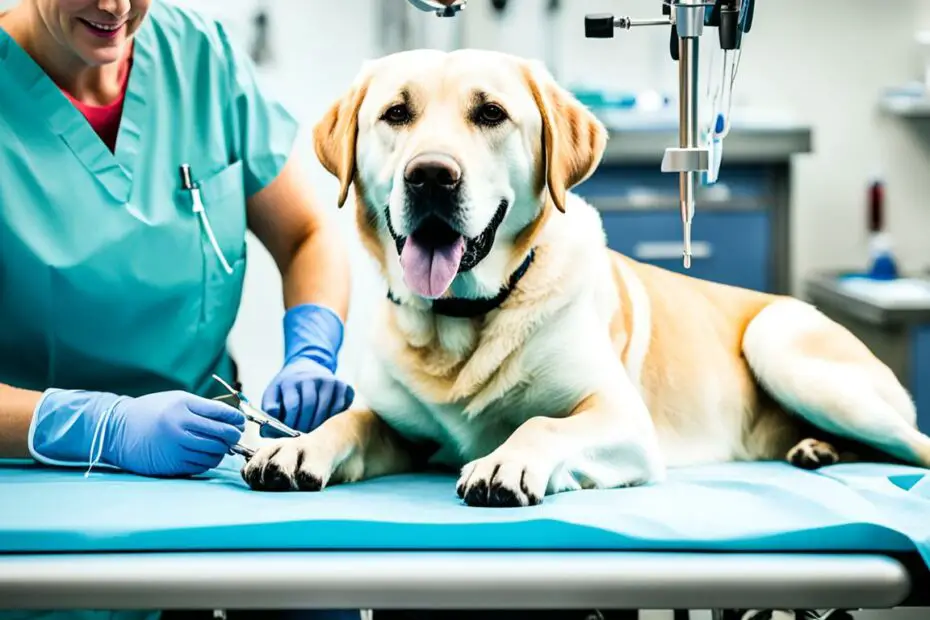When spaying or neutering a Labrador Retriever, one of the most common questions is, “When is the best time to do it?”
While there are varying opinions and beliefs, making an informed decision based on reliable guidelines and recommendations is crucial. This article provides the necessary information to help you determine the optimal timing for spaying or neutering your Lab.
So, when should you spay or neuter a Labrador Retriever? Let’s find out!
The Importance of Spaying and Neutering for Population Control
The Role of Pet Owners in Reducing Euthanasia
Spaying and neutering our Labradors can help prevent unplanned pregnancies and reduce the number of animals in overcrowded shelters.
Statistical Overview of Pet Overpopulation in the U.S.
Understanding the magnitude of the pet overpopulation problem can shed light on the importance of spaying and neutering. In the United States alone, millions of cats and dogs enter shelters yearly, with a significant portion never finding a forever home.
Understanding Labrador Retriever Reproductive Health
Labrador Retrievers, like any other breed, have specific reproductive health needs that should be considered. Hormones play a crucial role in their long-term health, and understanding their impact is vital for responsible pet ownership.
Additionally, preventing certain cancers through spaying or neutering is essential for Labrador Retriever owners.
How Hormones Impact Your Labrador’s Long-term Health
Hormones, such as estrogen and testosterone, significantly affect a Labrador Retriever’s overall well-being. Leaving your dog intact can lead to hormonal imbalances or issues related to reproductive organs. These imbalances may contribute to developing certain health conditions or behavioral problems.
Cancer Prevention and the Role of Sex Hormones
One of the benefits of spaying or neutering your Labrador Retriever is the potential to prevent certain types of cancers. For female Labs, spaying before their first heat cycle significantly reduces the risk of mammary tumors, which can be malignant.
In males, neutering eliminates the risk of testicular cancer. By removing the sex hormones involved in these cancer developments, such as estrogen and testosterone, spaying or neutering contributes to the prevention of these diseases.

| Benefit | Spay | Neuter |
|---|---|---|
| Cancer Prevention | Reduces the risk of mammary tumors in females | Eliminates the risk of testicular cancer in males |
| Behavioral Benefits | Reduces aggression and roaming tendencies | Reduces aggression and territorial marking behaviors |
| Population Control | Prevents unwanted litter and contributes to reducing euthanasia rates | Prevents unwanted litter and contributes to reducing euthanasia rates |
The Optimal Age Range for Spaying or Neutering Labrador Retrievers
To determine the best time for the procedure, research conducted by UC Davis on large breed dogs, including Labs, provides valuable insights. These guidelines consider dog size, breed, maturity, and growth plate closure.
UC Davis Research on Large Breed Dogs
UC Davis researched large breed dogs, including Labrador Retrievers, to determine the ideal timing for spaying or neutering. The studies aimed to find the balance between preventing reproductive-related health issues and potential complications associated with early or delayed sterilization.
Guidelines Based on Dog Size and Breed
Guidelines for spaying or neutering Labrador Retrievers are also influenced by dog size and breed factors. Certain breeds may have specific growth patterns and associated health risks, which need to be considered when determining the optimal age range for the procedure.
Exploring the Benefits of Labrador Spay and Neuter Procedures
Increased Lifespan and Health Improvements
Spaying or neutering your Labrador Retriever is crucial for their well-being, providing numerous health benefits and promoting a longer, healthier life. Research has consistently shown that these procedures significantly reduce the risk of various health issues, especially reproductive cancers.
For female Labs, spaying eliminates the risk of uterine infections and dramatically decreases the chance of developing mammary tumors. On the other hand, neutering male Labs helps prevent testicular cancer and lowers the risk of prostate problems.
Beyond safeguarding against specific health concerns, spaying or neutering contributes to a healthier life for your Labrador Retriever by eliminating the threat of severe reproductive conditions, such as pyometra in females—a potentially life-threatening uterine infection.
Additionally, neutered males are less prone to roaming and engaging in aggressive or territorial behaviors, minimizing the likelihood of accidents, injuries, and conflicts with other animals. This ensures their safety and fosters a more harmonious environment for both male and female Labradors.

Behavioral Changes Post-Surgery
One aspect pet owners often consider when contemplating spaying or neutering their Labradors is the potential for behavioral changes after the surgery.
While some animals may experience temporary post-surgical discomfort or behavior modifications due to anesthesia or pain medication, the long-term behavioral effects are generally positive.
Spayed females are less likely to display aggressive behaviors related to hormonal fluctuations during heat cycles. They also tend to have a calmer temperament and are less inclined to exhibit territorial marking or engage in excessive barking.
Neutered males experience reduced territorial and sexual behaviors, including marking, roaming, and aggression toward other animals.
When Should You Spay or Neuter a Labrador Retriever: Balancing Age and Health Risks
When deciding when to spay or neuter your Labrador Retriever, balancing age and health risks is crucial. Spaying refers to the surgical removal of a female dog’s reproductive organs, while neutering involves the removal of a male dog’s testicles. It’s a common procedure that offers various benefits, including population control and potential health advantages.
However, determining the optimal age for spaying or neutering your Lab requires careful consideration. Early-age or pediatric spaying/neutering has gained popularity in recent years, but assessing the potential risks associated with this approach is essential. On the other hand, delaying the procedure too long can also have health implications for your Lab.
It’s recommended to consult with your veterinarian to make an informed decision based on your Lab’s circumstances and breed-specific considerations. Vets can provide personalized guidance by evaluating your Lab’s growth, maturity, and overall health.
Some studies suggest that early-age spaying or neutering may increase the risk of certain health conditions, including musculoskeletal disorders and certain cancers, particularly in large breed dogs like Labradors. This has led to a discussion among veterinarians and researchers about the best age to perform the procedure.
Furthermore, the impact of spaying or neutering on Labrador Retrievers’ development is influenced by rapid growth and the closure of growth plates, the areas of developing cartilage near the ends of long bones. Neutering too early can interfere with the optimal development of bones and joints, leading to an increased risk of orthopedic conditions such as hip or elbow dysplasia.
Conversely, delaying the procedure too long may increase the chances of your Lab developing certain reproductive-related conditions, such as uterine infections or testicular tumors.
Labrador Neutering Guidelines and the Risk of Joint Disorders
Neutering, especially at an early age, has been associated with an increased risk of joint disorders in Labrador Retrievers. Following proper labrador neutering guidelines is important to ensure the best outcome for your furry friend’s long-term health.
Association Between Early Neutering and Orthopedic Issues
Research has shown that early neutering before the Labrador Retriever reaches full physical maturity can adversely affect their joint health. Studies suggest that neutering before one year may increase the risk of orthopedic issues such as hip or elbow dysplasia.
Removing sex hormones through early neutering can disrupt the normal growth and development of bones and joints in Labradors. These hormones are believed to play a crucial role in the proper formation and alignment of the skeletal structure.
Longevity of Non-Sterilized vs. Sterilized Labradors
The impact of neutering on the longevity of Labrador Retrievers has been a topic of interest among researchers. While there are varying opinions and conflicting studies on this matter, some research suggests that non-sterilized Labradors may have a slightly longer lifespan than their sterilized counterparts.
However, it is important to note that the difference in longevity between non-sterilized and sterilized Labradors is relatively small, and numerous other factors can influence a dog’s lifespan, such as genetics, overall health, and lifestyle.
How Labrador Spaying Recommendations Affect Canine Cancers
Spaying female Labrador Retrievers can have a significant impact on preventing certain types of cancers. Research and expert recommendations provide valuable insight into the spaying guidelines for female Labs and the role of spaying in preventing mammary and reproductive tumors.
Preventative Healthcare Considerations in Female Labs
When considering spaying for your female Labrador Retriever, it’s crucial to prioritize preventative healthcare. Spaying protects against mammary tumors, as studies show that the risk of developing malignant mammary tumors significantly decreases when a female Lab spays before her first heat cycle.
Additionally, spaying your female Lab reduces the risk of other reproductive-related health issues, including pyometra (an infection of the uterus) and ovarian or uterine cancer. Spaying protects against potentially life-threatening conditions and promotes your Lab’s long-term health and well-being.
The Impact of Spaying on Mammary and Reproductive Tumors
Spaying is crucial in preventing mammary and reproductive tumors in female Labrador Retrievers. The removal of the ovaries eliminates the hormonal fluctuations that can contribute to mammary tumor development. Research has shown that spaying before the first heat cycle can reduce the risk of malignant mammary tumors by up to 99% compared to intact females.
Labrador Spay and Neuter Considerations: Your Vet’s Perspective
Consulting with your veterinarian is crucial when deciding when to spay or neuter your Labrador Retriever. Your vet’s perspective will provide valuable insight into the best course of action for your furry friend. They will consider your Lab’s circumstances and tailor their recommendations to ensure the procedure meets their needs.
Personalizing the decision is key when spaying or neutering your Lab. Factors such as your dog’s age, overall health, and breed characteristics will be carefully assessed by your vet. They will consider any potential risks or benefits associated with timing and offer professional guidance to help you make an informed decision.
Case by Case: When Generic Guidelines Don’t Apply
While general guidelines exist for spaying and neutering Labrador Retrievers, it’s important to note that these recommendations may not always apply to every situation. Each Lab is unique, and factors such as growth and development, prior health history, and behavior should be considered. Your veterinarian will evaluate these factors and make recommendations customized to your Lab’s needs.
FAQ
Q: When should you spay or neuter a Labrador Retriever?
A: The optimal timing for spaying or neutering a Labrador Retriever can vary, but it is generally recommended between 6 and 9 months of age. However, it is important to consult your veterinarian to determine your dog’s best age.
Q: What is the importance of spaying and neutering for population control?
A: Spaying and neutering Labrador Retrievers are crucial in controlling the pet population and reducing the number of animals in shelters. It helps prevent unwanted litter and contributes to the overall welfare of animals.
Q: What is the role of pet owners in reducing euthanasia?
A: Pet owners are responsible for spaying or neutering their Labrador Retrievers to help reduce euthanasia rates. By preventing unplanned litter, we can decrease the number of animals in shelters and ultimately reduce the need for euthanasia.
Q: What is the statistical overview of pet overpopulation in the U.S.?
A: Pet overpopulation is a significant problem in the United States. Each year, millions of animals, including Labrador Retrievers, enter shelters, and many are euthanized due to a lack of available homes. Spaying or neutering your Lab can help alleviate this issue and reduce the burden on shelters.
Q: How do hormones impact a Labrador Retriever’s long-term health?
A: Hormones can significantly impact a Labrador Retriever’s long-term health. Leaving your dog intact (not spayed or neutered) can increase the risk of certain cancers and reproductive health issues. Spaying or neutering can help prevent these health problems.
Q: What is the link between spaying or neutering and preventing certain cancers?
A: Spaying female Labrador Retrievers can significantly reduce the risk of mammary tumors and other reproductive cancers. Neutering male Labs can also decrease the occurrence of testicular and prostate cancers. These procedures help address the role of hormones in cancer development.
Q: What is the optimal age range for spaying or neutering Labrador Retrievers?
A: The ideal timing for spaying or neutering a Labrador Retriever is between 6 and 9 months of age. However, this can vary depending on several factors, such as dog size, breed, and individual maturity. Consult with your veterinarian to determine the best age for your Lab.
Q: What are the benefits of Labrador spay and neuter procedures?
A: Spaying or neutering your Labrador Retriever offers numerous benefits, including increased lifespan and improvements in overall health. These procedures also reduce the risk of certain cancers and can positively affect behavior, such as reducing aggression and roaming tendencies.
Q: What health risks are associated with early or delayed spaying or neutering?
A: Potential health risks are associated with early or delayed spaying or neutering. Neutering at an early age has been linked to an increased risk of joint disorders in Labrador Retrievers. Delayed spaying can increase the risk of mammary tumors in female Labs. Finding the right balance between age and health risks is crucial.
Q: What is the association between early neutering and orthopedic issues in Labrador Retrievers?
A: Neutering Labrador Retrievers at an early age, especially before they have fully matured, has been associated with an increased risk of orthopedic issues such as hip or elbow dysplasia. When deciding when to neuter your Lab, it is important to consider the potential impact on joint health.
Q: How does non-sterilized Labrador Retrievers’ longevity compare to sterilized Labs?
A: Research has shown that non-sterilized Labrador Retrievers may have, on average, a shorter lifespan compared to their sterilized counterparts. Spaying or neutering your Lab can improve their overall health and extend their lifespan.
Q: What are spaying recommendations for female Labrador Retrievers?
A: It is generally recommended to spay female Labrador Retrievers before their first heat cycle, which usually occurs around 6 months of age. Spaying at this stage significantly reduces the risk of mammary tumors and eliminates the risk of reproductive issues such as pyometra (a potentially life-threatening infection of the uterus).
Q: How does spaying impact the prevention of mammary and reproductive tumors in Labs?
A: Spaying female Labrador Retrievers significantly reduces the risk of mammary tumors, especially if done before their first heat cycle. It also eliminates the risk of reproductive tumors such as ovarian or uterine cancer. Spaying is crucial in preventing these types of cancers in female Labs.
Q: How important is it to consult a veterinarian when deciding when to spay or neuter a Labrador Retriever?
A: Consulting with a veterinarian is crucial when deciding the best timing for spaying or neutering your Labrador Retriever. They can assess your Lab’s circumstances, discuss potential health risks, and provide personalized recommendations based on their expertise and knowledge. Veterinarians are vital in helping you make the best decision for your Lab’s health and well-being.
Q: What factors should be discussed with a veterinarian to personalize the decision?
A: When considering when to spay or neuter your Labrador Retriever, several factors should be discussed with your veterinarian. These may include the Lab’s breed, size, overall health, behavior, and any specific considerations or concerns you may have. Personalizing the decision ensures that your Lab’s unique needs are considered.
Q: Are there situations where generic guidelines may not apply?
A: Yes, there are situations where generic spaying or neutering guidelines may not apply. Each Labrador Retriever is an individual, and certain factors may require a case-by-case assessment. Consulting with a veterinarian is important to determine the best action for your Lab’s health and well-being.

